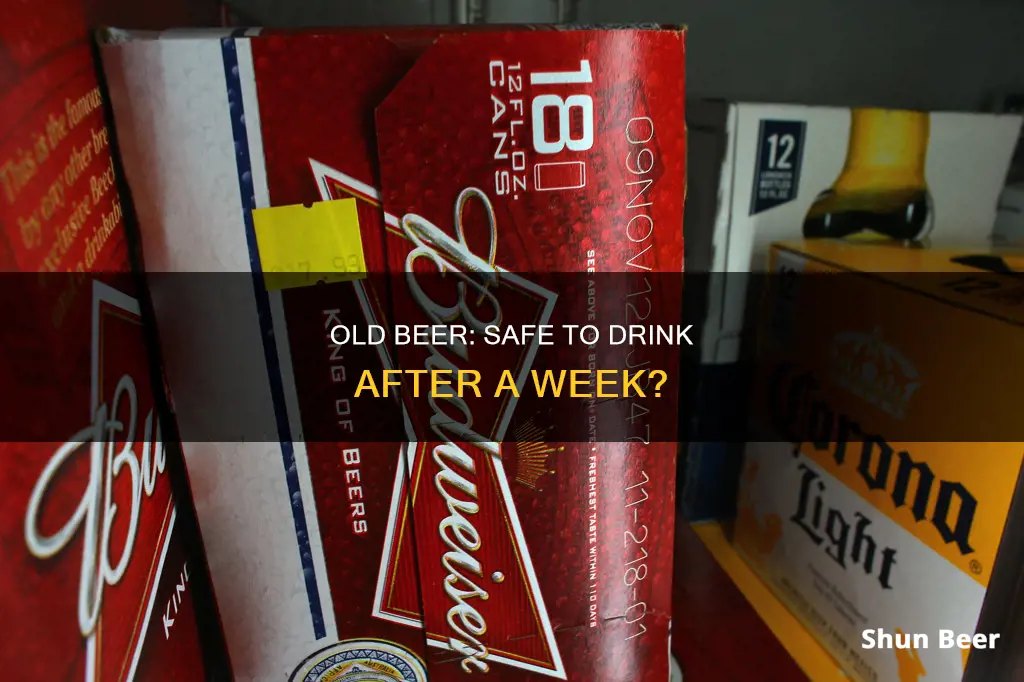
Beer is a perishable product that can be drunk after its best before date, but its flavour will degrade over time. Beer stales when exposed to light, oxygen, and heat, which break down the organic compounds that give beer its flavour and aroma. However, even when its flavour is declining, it can be perfectly safe to drink. Beer is either pasteurised or filtered to eliminate bacteria, so it's extremely resistant to spoiling.
| Characteristics | Values |
|---|---|
| Is week-old beer safe to drink? | Yes, beer can be safely consumed past its expiration date, though the flavour will degrade over time. |
| Why does beer degrade? | Beer is perishable and stales when exposed to light, oxygen, and heat, which break down the organic compounds that give beer its flavour and taste. |
| How long does beer last? | Beer lasts about 5-9 months beyond the expiration date at room temperature. In a refrigerator, unopened beer can last up to 2-3 years. Opened beer has a shelf life of about a day. |
| How to store beer | Store beer in a cool, dark place, away from temperature fluctuations. Keep it upright to minimise oxidation and avoid exposing it to direct sunlight. |
What You'll Learn

Beer is safe to drink past its expiration date
Beer is generally safe to drink past its expiration date. While beer does expire, it doesn't pose the same health risks as expired food. Neil Witte, one of only 22 Master Cicerones in the world, explains that "beer expires, but [it] doesn't expire in the same way that a lot of people think of when they think of food." Unlike food, the alcohol content in beer and the presence of hops, which have antimicrobial characteristics, prevent pathogenic bacterial growth that can make you sick. Therefore, while expired beer may taste bad due to oxidation and the loss of hop aromas, it is unlikely to cause illness.
The shelf life of beer depends on various factors, including the type of beer, its packaging, and storage conditions. Most beers have a "best before" date, which is a guideline for quality rather than safety. At room temperature, beer typically lasts 5 to 9 months beyond its expiration date, while refrigeration can extend its shelf life by a few years. Canned beer generally lasts longer than bottled beer because cans block out light, slowing the oxidation process. However, the type of beer also plays a role, with stronger beers like stouts and porters tending to have a longer shelf life than lighter beers like lagers and pilsners.
To maximize the shelf life of beer, it is recommended to store it in a cool, dark place, away from direct sunlight and temperature fluctuations. Additionally, keeping beer upright can help minimize oxidation. While drinking beer past its expiration date is generally safe, it is important to note that the taste and quality may deteriorate over time.
Some beers, like certain high-alcohol beers, malt-forward styles, and speciality beers, can actually improve with age. These beers are often brewed with aging in mind and can develop complex flavours over time. On the other hand, IPAs and other hoppy beers are best consumed fresh, as they gradually lose their flavour and aroma.
Beer and Apple: A Delicious Pairing?
You may want to see also

Beer's flavour degrades over time
Beer flavour instability is a critical quality problem faced by the brewing industry. Beer flavour can change during aging, and these changes can influence consumer acceptance within shelf life. The shelf life of beer is defined as the period over which flavour changes remain acceptable. Beer ageing is characterised by a decreased bitter taste and an increased sweet/caramel taste, with ribes (black currant), toffee and sherry-like aromas.
During the ageing process, desirable aroma compounds such as isoamyl acetate decrease, while undesirable aroma compounds increase in concentration. The main indicators of ageing are aldehydes from the Maillard reaction, Strecker degradation, and lipid oxidation. Other aroma compounds, such as hop degradation products, ketones, lactones, and ethyl esters, also increase over time and contribute to an aged flavour.
The formation process of volatile ageing compounds is highly complex, involving many physicochemical influences, such as temperature, time, pH, and oxygen level, in packaged beer, in the malt, and in the brewhouse. These mechanisms are interdependent and in equilibrium with non-volatiles throughout the brewing process.
The rate of oxidation, a key factor in beer staling, is influenced by temperature. To avoid excessive beer exposure to oxygen, the headspace reserved for the beer in the bottle should be less than one inch. If the beer is to be stored, the temperature inside its container should be kept below 50 °F (10 °C).
Other factors that can influence the flavour of beer include improper production processes or improper storage. For example, if the external ambient temperature during fermentation is lower than 26 °C (79 °F), diacetyl is absorbed insufficiently, resulting in a threshold of less than 0.04 mg/liter in beer, which gives the beer a mouthfeel similar to cream cheese. The resulting odour will persist over time.
Hydration Station: Water and Beer's Uneasy Truce
You may want to see also

Beer is perishable and stales when exposed to light, oxygen and heat
Beer is perishable and will eventually go stale, even if stored in a refrigerator. However, it will not be unsafe to drink in terms of food poisoning, as no harmful pathogens grow once the beer is fully fermented.
Oxygen is the main culprit of stale-tasting beer. It can enter the beer at multiple points during the brewing, bottling, and packaging processes. Exposure to oxygen degrades lively alcohols and aromatics into bland shells of their former selves, producing tones of sherry, paper, and cardboard. Hop aromas are also muted, and hop beta acids oxidize to produce an unrefined bitterness.
Brewers go to great lengths to limit the amount of oxygen in their beer, as it can spoil the long-term stability of the beer's flavor and clarity. However, oxygen is necessary during the fermentation process to allow healthy yeast growth.
Other factors that can cause beer to go stale are exposure to light and heat. Beer should be stored in a cool, dark area, between 45°F and 55°F.
Beer Overload: Stinging Sensation in Pee?
You may want to see also

Beer doesn't expire like milk does
The reason beer doesn't expire in the same way as other consumables is that there's no pathogenic bacterial growth. The alcohol content, the presence of hops, and the low pH of beer all prevent harmful pathogens from growing.
That said, beer can still go bad in several ways. For example, when beer comes into contact with oxygen during the brewing, packaging, or storage process, it can oxidise, causing a cardboard-like or stale taste. Beer can also become "skunky" when exposed to UV light, developing a distinctive sulfur-like smell and taste.
Commercial beers are well-pasteurised and filtered, but homebrews or improperly sealed commercial brews can be susceptible to bacterial contamination, which can cause sour, musty, or metallic flavours.
Temperature fluctuations can also affect beer quality. High temperatures can cause chemical reactions that break down flavour compounds, while freezing can cause the beer to expand and introduce oxygen when thawing.
Over time, all beer will undergo chemical changes that alter its flavour, aroma, and mouthfeel. Aging causes the aromas and hop flavours to mellow, and the malt flavour to become stronger. This is desirable for some beers, such as high-ABV beers, but it can mean a loss of the intended profile for others, like IPAs.
So, while beer doesn't expire in the same way as milk, it's still best to drink it as fresh as possible to ensure optimal flavour and quality.
Beer and Breastfeeding: Does Beer Increase Milk Supply?
You may want to see also

Beer lasts longer in the fridge
Beer is a perishable product that can be sensitive to light, oxygen, and heat. However, it is resistant to spoiling and can be safe to drink long after its "best before" date. The main concern with drinking old beer is the taste, as it will degrade over time.
Beer stored in a refrigerator can last up to two or three years unopened, and about a day opened. This is because refrigeration slows the process of aging. Beer stored at room temperature will only last about 5 to 9 months beyond the expiration date listed on the label.
The type of beer also affects its shelf life. Stronger beers, such as stouts, porters, and high-alcohol content beers, tend to last longer than lighter beers like lagers and pilsners. Hoppy beers, like IPAs, are best consumed fresh to enjoy their full flavour and aroma.
Additionally, light exposure, especially UV rays, can cause beer to develop a skunky odour and taste. This is more common in beers packaged in clear or green bottles, as brown bottles and cans offer better protection from light.
In summary, beer lasts longer in the fridge, both opened and unopened. To maximise the shelf life of beer, it is best to store it in a cool, dark place, upright, and away from temperature fluctuations.
Beer Drinking: A Culprit for High Uric Acid?
You may want to see also
Frequently asked questions
Yes, week-old beer is safe to drink. Beer doesn't expire in the same way milk does, and it takes quite some time for the brew to turn bad. However, it's best to consume it within three to six months of packaging or before its best-by date for optimal taste.
Drinking expired beer won't make you sick, but you may experience unpleasant tastes and aromas. The beer's flavour will degrade over time as it becomes flat and sweeter.
Beer lasts about 5 to 9 months beyond the expiration date listed on the label at room temperature. In a refrigerator, unopened beer can last up to two or three years. Opened beer has a shelf life of about a day, regardless of the expiration date.
You can examine the colour, smell, taste, foam density, and overall appearance of the beer. If the beer is only slightly past its prime, it may be challenging to tell. However, when it has truly gone bad, you will likely notice something is off before taking a sip.
The type of beer, packaging, and storage conditions all influence its shelf life. Stronger beers like stouts and porters tend to last longer than lighter beers. Beer in transparent or green bottles has shorter shelf lives due to light exposure, whereas brown bottles and cans offer better protection. Storing beer in a cool, dark place, away from temperature fluctuations, will help extend its shelf life.







